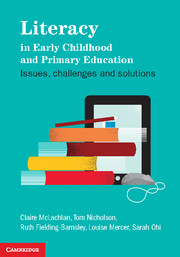Book contents
- Frontmatter
- Contents
- List of figures
- List of tables
- About the authors
- Acknowledgements
- Chapter 1 Introduction
- Part 1 Literacy acquisition: the child, the family and diversity in the modern world
- Part 2 Learning about literacy in early childhood settings
- Chapter 7 Effective practice and the role of teachers in supporting literacy
- Chapter 8 ‘Sound’ foundations for learning literacy
- Chapter 9 Uses of assessment before, during and after transition to school
- Part 3 Literacy learning in the primary school
- Part 4 Literacy learning in the senior primary school
- References
- Index
Chapter 9 - Uses of assessment before, during and after transition to school
from Part 2 - Learning about literacy in early childhood settings
- Frontmatter
- Contents
- List of figures
- List of tables
- About the authors
- Acknowledgements
- Chapter 1 Introduction
- Part 1 Literacy acquisition: the child, the family and diversity in the modern world
- Part 2 Learning about literacy in early childhood settings
- Chapter 7 Effective practice and the role of teachers in supporting literacy
- Chapter 8 ‘Sound’ foundations for learning literacy
- Chapter 9 Uses of assessment before, during and after transition to school
- Part 3 Literacy learning in the primary school
- Part 4 Literacy learning in the senior primary school
- References
- Index
Summary
Chapter objectives
To develop an understanding of the principles of effective literacy assessment.
To review the purposes and types of assessment that occur before, during and after a child’s transition to school.
To critically examine a range of methods for assessing and documenting children’s developing literacy skills and strategies.
This chapter reviews literature on effective assessment, particularly of literacy, and examines this in relation to methods of assessment that are commonly used in early childhood settings. Principles for effectively assessing children’s literacy progress before, during and after the initial transition to school are developed. A range of potential methods for assessing and documenting children’s literacy acquisition prior to school entry are explored and critiqued. The importance of documenting literacy progression that can be effectively used by the early childhood setting, the primary school and parents is a particular focus of this chapter.
Setting the scene for assessment
In Chapter 1 we introduced you to four students to help you begin thinking about literacy as well as the theoretical frameworks and pedagogies that underpin literacy development in early childhood and primary settings. In this chapter, we’d like you to think about two of these students (Scenarios 1.1 and 1.2) again: the active four-year-old boy with little interest in learning indoors, and the five-year-old girl who is already reading (and comprehending) chapter books. You will undoubtedly meet children like this boy and girl in your teaching practice.
- Type
- Chapter
- Information
- Literacy in Early Childhood and Primary EducationIssues, Challenges, Solutions, pp. 140 - 158Publisher: Cambridge University PressPrint publication year: 2012



